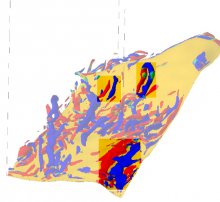Turbulence in stable atmospheric boundary layer, and more precisely on
the very close
vicinity of the ground (first tens meters), is often parametrized on
numerical atmospheric models
commonly used. The aim of the present work is to better understand the
behavior of the turbulence
witch could be very strong into down-slope flows. We study such a
realistic down-slope flow thanks
to a very high resolution simulation. The french model, MesoNH
(Meteo-France and Laboratoire
d’Aerologie, Toulouse,France), is used down explicitly to the two first
meters above the ground in a
complex topography. We model an existing mountain slope overlooking
Grenoble (french Alps).
The atmospheric initial conditions and external forcing are chosen from
a latter study of Yann
Largeron, 2010 [1] who highlighted the strong correlation between
persistent stable atmospheric
conditions and strongly polluted events in this region (cold air pool
phenomenon). The computed
flow is studied with statistics and has shown interesting similarities
with an adjusted model from the
revisiting Prandtl model by Fedorovich and Shapiro, 2009 [2]. When
radiative cooling at the surface
is sufficient, a katabatic flow is observed as a few meters thick
wall-jet with a maximum speed of
few meters per second. Results have also revealed interesting turbulent
structures on the external
gradient of the low-level jet.
The forthcoming work is based on characterizing the various processes on
natural thus complex
configuration.

Accueil > Équipes > Équipe MEIGE > Diffusion scientifique > Séminaires internes
LES katabatic flow modeling on realistic configuration.
Sebastien Blein, 14/06/2012





